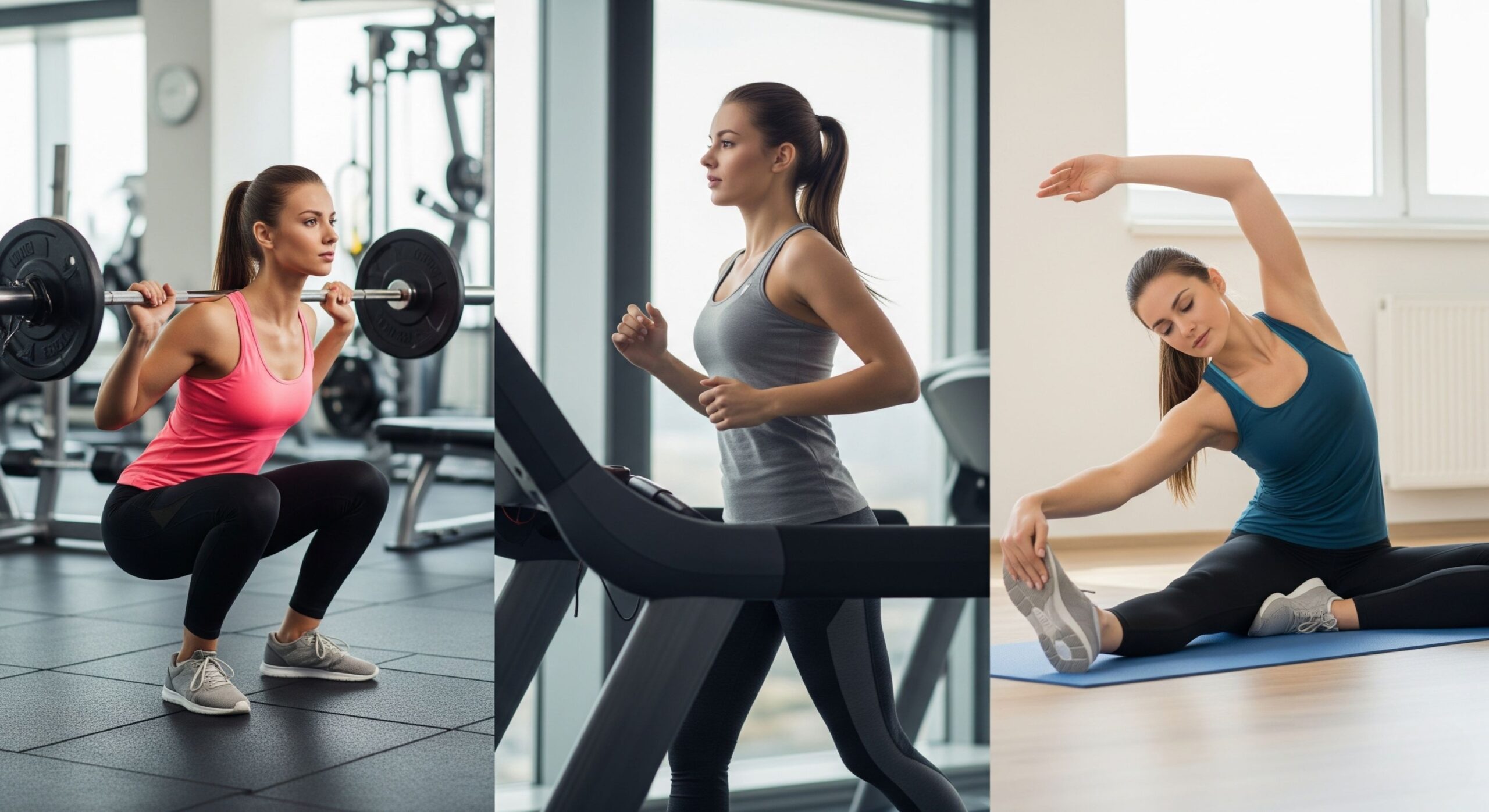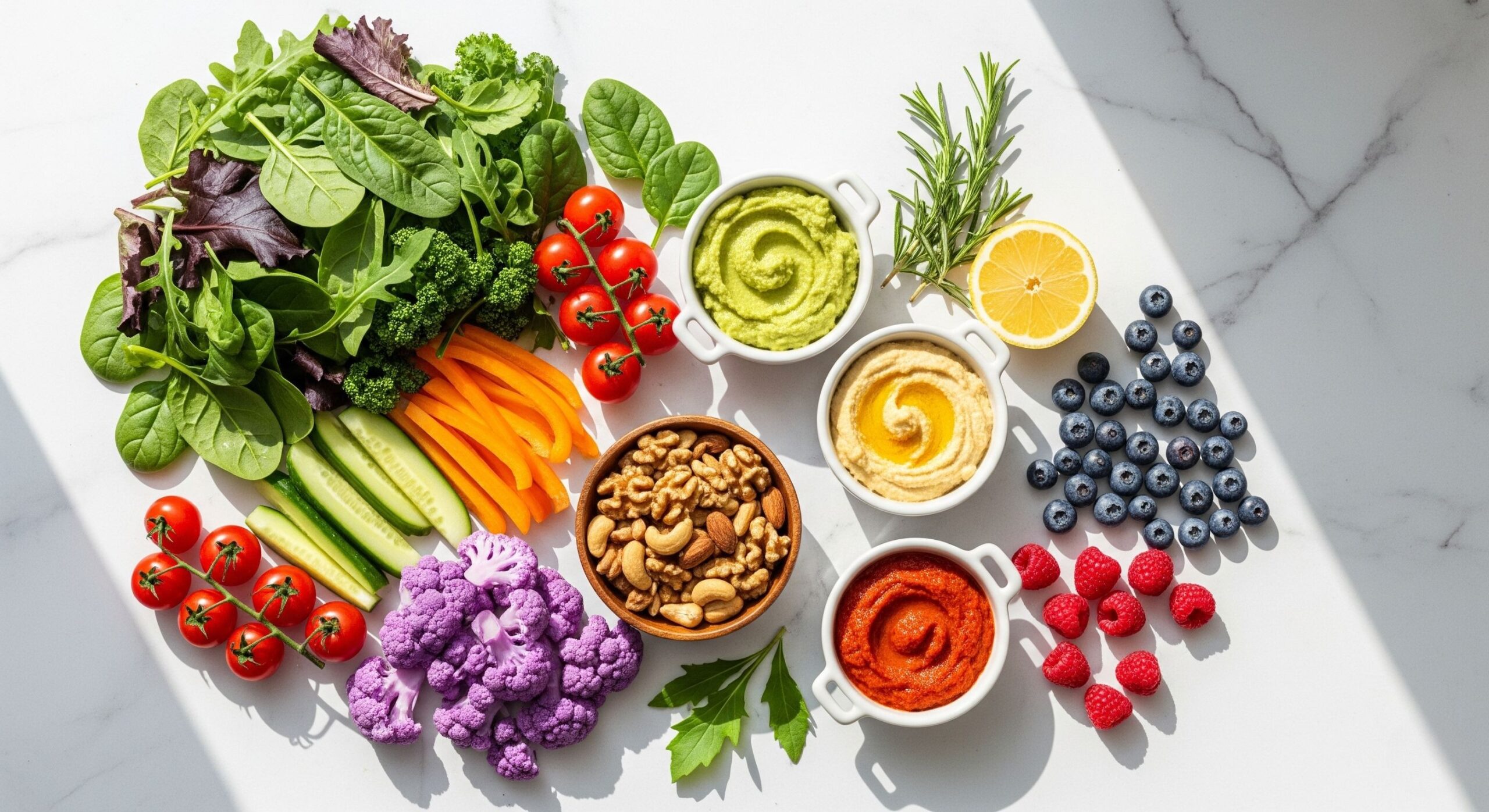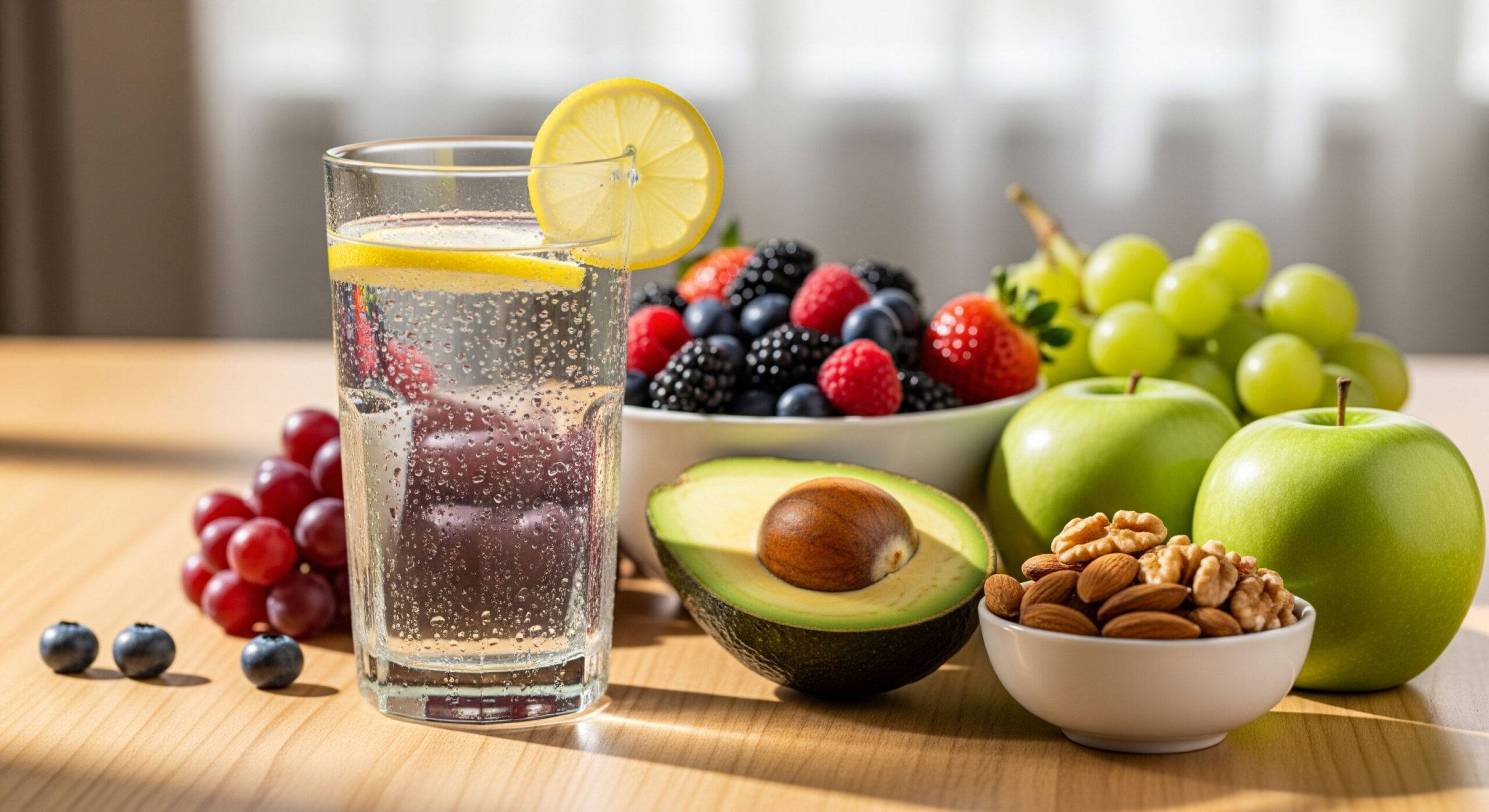
Introduction: A New Approach in the Digital Age
Let’s be real: in our fast-paced world, trying to live a healthy lifestyle can feel overwhelming. We’re constantly hit with fad diets, extreme workouts, and productivity hacks that promise the world. Indeed, it’s a flood of information that leaves many of us feeling like we’re always falling short. The demands from work, social media, and life can leave us drained and disconnected. But here’s the secret: a truly holistic healthy lifestyle isn’t about achieving some impossible standard of perfection. Instead, it’s a personal journey toward true wellness and lasting well-being, one that respects your unique body and mind.
From Fad Diets to Foundational Habits
In other words, this is about building sustainable habits that create a foundation for a vibrant life—not just for a few weeks, but for years to come. In 2025, our well-being is no longer a luxury; it’s our most important asset. This guide, therefore, is here to reframe your perspective. Specifically, it gives you a holistic plan that weaves together physical, mental, and emotional health in a way that actually fits modern life. We’re going to move past the superficial and into practical, actionable steps using proven health tips and effective fitness routines. In short, we’ll show you how to build a life that feels as good on the inside as it looks on the outside.
Our Philosophy: Wellness as Harmony, Not Hardship
Our philosophy is simple: wellness should be about harmony, not hardship. It’s about ditching the “all or nothing” mentality that so often leads to burnout. For example, you’ll learn to see food as nourishing fuel, not just numbers on a chart. You’ll reframe exercise as a celebration of what your body can do, not a punishment for what you ate. And you’ll discover mindfulness as a powerful tool for finding peace in the chaos. Furthermore, we’ll explore the science of habit formation, the art of listening to your body, and the power of human connection. By the end, you’ll have a clear blueprint for what a holistic approach to wellness habits truly looks like and an actionable plan to make it stick. This is your guide to a happier you in 2025 and beyond.
Quick Navigation: Jump to Nutrition Fundamentals | Exercise & Fitness | Mental Health | Sleep Optimization
The Foundation of a Holistic Healthy Lifestyle: A Balanced Perspective
A truly healthy life is a balanced one. Think of it like a building supported by four key pillars that hold up your overall well-being. For instance, if one pillar weakens, it affects the entire structure. The goal isn’t to perfect one area while neglecting others, but rather to create a harmony where each pillar strengthens the others. So, let’s dive into the core principles of a thriving holistic health plan that truly works for the long haul.

True wellness is about balancing the scales, not just chasing a number.
Physical Health: The Cornerstone of Your Holistic Healthy Lifestyle
Your body is the only vehicle you get for this life, and how you treat it determines how it performs. This isn’t just about weight; it’s about boosting your energy, mood, and long-term vitality through smart health and wellness practices. These practices are the very basis of a holistic healthy lifestyle.
Nourish with Nutrient-Dense Foods
First and foremost, nutrition is everything. This isn’t about strict rules, but rather about fueling your body with nutrient-dense foods. Focus on a balanced diet packed with whole foods—fresh fruits, colorful vegetables, lean proteins, and healthy fats. After all, these foods provide the essential vitamins, minerals, and fiber your body craves to function at its best.
Embrace Consistent Movement
Equally important is consistent exercise and movement as part of a solid fitness routine. Indeed, physical activity is a cornerstone of health. It gets your blood pumping, strengthens your muscles and bones, and releases mood-boosting endorphins. To be effective, a good routine should mix cardio (for your heart), strength training (to boost metabolism), and flexibility (to prevent injury). Think of it as a daily act of self-respect for your incredible body. In fact, it’s one of the most effective health tips you can follow.
Prioritize Restorative Sleep
And then there’s quality sleep—the non-negotiable foundation of your wellness. Specifically, during these crucial hours, your body enters its main repair phase. While you sleep, your body is hard at work repairing muscles, storing memories, and regulating key hormones. Skimping on sleep can lead to weight gain, a weaker immune system, and brain fog. Therefore, you should aim for 7-9 hours of quality sleep each night. A cool, dark, and quiet room is your best friend for deep, restorative rest.
“Physical inactivity is one of the leading risk factors for noncommunicable diseases such as cardiovascular diseases, cancer and diabetes.”
— World Health Organization (WHO)
Mental and Emotional Wellness: A Pillar of a Holistic Healthy Lifestyle
A healthy mind is just as critical as a healthy body for true well-being. In today’s high-stress world, burnout and anxiety are common, but they don’t have to be your reality. Consequently, a complete holistic healthy lifestyle must include strategies for mental clarity and emotional balance.
Mastering Modern Stress for a Balanced Life
Effective stress management techniques are your secret weapon against modern pressures. For example, practices like meditation, deep breathing, and journaling can keep you centered. The 4-7-8 breathing technique, for instance, is a simple way to activate your body’s relaxation response. Similarly, mindfulness—the act of being present without judgment—can dramatically reduce anxiety. It helps you see your thoughts as passing clouds rather than letting them control you.
Nurture Your Social Connections for Well-Being
Finally, never underestimate the power of social connection. In our digital age, genuine human interaction is more important than ever. Nurturing your relationships with friends and family provides a vital support system, fights loneliness, and is linked to a longer, happier life. So, make time for meaningful conversations, shared activities, and laughter. Prioritizing human connection is a powerful act of self-care.
Building Habits for a Holistic Healthy Lifestyle That Stick: The Science of Lasting Change
Turning your wellness goals into a permanent reality is less about willpower and more about strategy. To make lasting lifestyle changes, you need to understand the science of how habits are formed. The key is to make healthy choices so easy and rewarding that they become automatic. In essence, it’s about working with your brain’s natural wiring, not against it, to build a system that supports your new holistic healthy lifestyle.

Designing your habits is like writing a new story for your life.
The Science of Habit Formation: Cue, Routine, Reward
Understanding the Habit Loop
Essentially, every habit, good or bad, follows a simple three-step loop: a cue (the trigger), a routine (the action), and a reward (the benefit that makes your brain want to do it again). For example, a stressful deadline (cue) might make you reach for a sugary snack (routine), which gives you a moment of pleasure (reward). Therefore, to build a new habit, you have to design this loop yourself. First, pick a cue, then define a simple routine, and finally, make sure the reward is satisfying enough to reinforce the behavior.
Using Habit Stacking to Your Advantage
A great way to apply this is with “habit stacking,” a technique from the book *Atomic Habits*. This involves linking a new habit you want to start with one you already have. For instance, “After I pour my morning coffee, I will meditate for two minutes.” In this case, your existing coffee habit becomes the cue for your new meditation habit. This simple trick makes new behaviors feel much more natural and easier to adopt.
Design Your Environment for a Holistic Healthy Lifestyle
Your environment is a powerful, silent force that shapes your daily actions. Instead of relying on willpower, which can run out, you should design your surroundings to make healthy choices the easiest ones. In reality, this is about making your desired habits obvious and attractive. For example, if you want to eat more fruit, keep a fruit bowl on your kitchen counter, not hidden away. Want to work out in the morning? Lay out your gym clothes the night before. By removing friction, you make good habits almost effortless.
The 1% Improvement Method for a Holistic Healthy Lifestyle
A total life overhaul is exhausting and often leads to failure. Instead, focus on getting just 1% better each day. This idea is perfect for building a sustainable holistic healthy lifestyle. The changes can be incredibly small, like swapping one soda for water or going to bed 15 minutes earlier. These tiny lifestyle changes compound over time. In fact, a 1% improvement each day makes you nearly 38 times better by the end of the year. This approach builds momentum and self-belief, leading to huge transformations in your overall health and wellness.
Next Steps: Ready to implement these strategies? Jump to our 30-day healthy lifestyle challenge to get started.
Nutrition for Optimal Health: A Holistic Healthy Lifestyle Pillar
Good nutrition is the bedrock of a vibrant life. The food you eat directly impacts your energy, mood, and long-term health. It provides the raw materials your body needs to function, repair, and thrive. Understanding the basics can empower you to make smarter choices without getting bogged down by complicated rules. This is about nourishing your body from the inside out as a key part of your holistic healthy lifestyle.

Fuel your body with the good stuff—it’s the ultimate form of self-care.
Macronutrients and Micronutrients: Your Body’s Building Blocks
Your body runs on two main types of nutrients: macronutrients and micronutrients. Carbohydrates are your body’s main fuel source. It’s best to choose complex carbs like quinoa and sweet potatoes, which provide sustained energy. Proteins, similarly, are essential for building and repairing everything from muscles to skin. You can get them from lean meats, fish, beans, and nuts. Meanwhile, healthy fats from foods like avocados and salmon are critical for hormone production and brain health. Ultimately, a colorful, varied diet ensures you get the full range of vitamins and minerals, too.
Whole Foods vs. Processed Foods: The Quality Difference
The difference is simple but profound for your holistic healthy lifestyle. Whole foods are in their natural state—think apples, spinach, and almonds. Processed foods, on the other hand, have often been altered with added sugar, unhealthy fats, and preservatives. Consequently, one of the best things you can do for your health is to build your diet around whole foods. They are packed with fiber, which aids digestion and keeps you full. This doesn’t mean you can never have a treat, but it does mean making real, unprocessed food the star of your meals at least 80% of the time. For those looking to kickstart this process, a structured science-backed detox plan can help reset your palate and focus on whole foods.
Meal Planning, Mindful Eating, and Gut Health for Complete Wellness
A lack of planning is one of the biggest roadblocks to healthy eating. Therefore, try to dedicate an hour or two on the weekend to plan your meals and prep some ingredients. As a result, this simple habit saves you from making poor choices when you’re tired and hungry. Beyond planning, practice mindful eating. Pay attention to your food, eat slowly, and avoid distractions. This helps you recognize your body’s natural hunger and fullness cues. Also, don’t forget your gut! A healthy gut influences everything from immunity to mood. So, feed it well with fiber-rich and probiotic foods like yogurt and kimchi.
Hydration Is Key for a Healthy Body
Proper hydration is critical. Every cell in your body needs water to function. Water, for example, carries nutrients, regulates body temperature, and keeps your energy levels up. Even mild dehydration can cause fatigue and headaches. A good rule is to aim for half your body weight in ounces of water per day. Keep a reusable water bottle with you as a constant reminder. If plain water feels boring, try infusing it with lemon, cucumber, or mint.
Nutrition Tip: Start your 30-day challenge by focusing on hydration and adding more whole foods to your meals.
Exercise and Physical Activity for a Holistic Healthy Lifestyle
Exercise is a celebration of what your body can do. It’s not about punishment or looking a certain way; it’s about feeling strong, energetic, and alive. A great fitness routine mixes different types of movement to build a resilient body and mind, supporting your total well-being. The goal is to find a rhythm that feels good and fits into your life.

Movement is medicine for the body and soul. Find what makes you feel alive.
The Three Pillars of Fitness for a Complete Healthy Lifestyle
A balanced fitness routine rests on three pillars. First, Cardiovascular exercise (like brisk walking or cycling) strengthens your heart and lungs. You should aim for at least 150 minutes of moderate-intensity cardio a week. Next, strength training builds lean muscle and bone density, which boosts your metabolism. You don’t need a gym—bodyweight exercises like squats and push-ups are very effective. Finally, flexibility work, like yoga or simple stretching, improves your range of motion and reduces soreness.
Find the Joy in Movement
The best workout is the one you actually do. If you hate the gym, then don’t go! The key to consistency is finding activities that feel like play. It could be dancing, hiking, or joining a local sports league. When you reframe exercise as a source of joy instead of a chore, it becomes a natural part of your wellness routine. For that reason, experiment with different activities until you find a few you genuinely look forward to.
As the Mayo Clinic says, regular physical activity can improve your mood, boost your energy, and promote better sleep. In other words, it’s a win-win-win for your well-being.
Starting Your Fitness Journey: Keep It Simple and Safe
If you’re new to fitness, start slow. The goal is to build a habit, not to burn out. Begin with short walks or simple bodyweight exercises. Above all, listen to your body and take rest days—that’s when your muscles repair and grow stronger. Furthermore, a proper warm-up and cool-down are also essential to prevent injury. Remember, consistency beats intensity every time. A 20-minute walk every day, for instance, is far more beneficial than one punishing workout a week.
Sneak Movement Into Your Day
You don’t need a dedicated hour to be active. Since modern life is busy, look for small opportunities to move throughout your day. Take the stairs instead of the elevator. Park farther away from the store. Do squats while you wait for your coffee to brew. In the end, these “movement snacks” add up quickly and have a huge impact on your overall health and wellness.
Fitness Tip: Combine your exercise goals with proper nutrition and quality sleep for the best results.
Mental Wellness: Your Inner Strength for a Holistic Healthy Lifestyle
You can’t have a truly healthy life without prioritizing your mental and emotional health. Indeed, your mental state affects everything, from your physical health to how you handle life’s ups and downs. Learning to manage stress, cultivate a positive mindset, and build resilience is a superpower in the modern world.

Inner peace isn’t a destination; it’s a practice you cultivate daily.
Recognize the Signs of Stress and Burnout
In reality, stress isn’t just a feeling; it’s a physical response that floods your body with hormones like cortisol. While helpful in short bursts, chronic stress can be damaging. Signs can include constant fatigue, irritability, trouble concentrating, or changes in sleep. Recognizing these early signs is the first step. Therefore, pay attention to your body and mind. Ignoring them can lead to more serious issues. This is why learning to say “no” and setting healthy boundaries is a crucial part of self-care.
Techniques for Emotional Regulation
Emotional regulation is the ability to manage your emotional responses in a healthy way. One of the most powerful tools is mindful breathing. A few slow, deep breaths can instantly calm your nervous system. Journaling is another great tool that allows you to process your thoughts and feelings without judgment. Another technique is cognitive reframing, where you actively challenge a negative thought. For example, instead of thinking, “I can’t handle this,” you can reframe it to, “This is challenging, but I can figure it out.”
Build Resilience and Mental Strength for a Holistic Healthy Lifestyle
Resilience is your ability to bounce back from tough times, and it’s a skill you can build. For instance, practice reframing challenges as opportunities for growth. Celebrate your small wins to build self-belief. Be kind to yourself when you stumble. Another powerful practice is gratitude. At the end of each day, write down three things you are grateful for. This simple act trains your brain to focus on the positive. Similarly, spending time in nature is also a proven way to reduce stress and improve your mood.
Know When to Seek Professional Help
Sometimes, life’s challenges are too much to handle on your own, and that’s okay. Seeking help from a therapist is a sign of strength, not weakness. They are trained professionals who can give you tools and strategies to navigate difficult times. So, if you’re struggling with persistent feelings of sadness or anxiety, reaching out is the bravest thing you can do. Prioritizing your mental health is a non-negotiable part of a holistic healthy lifestyle.
Mental Health Tip: Combine stress management techniques with quality sleep and regular physical activity for a powerful wellness synergy.
Sleep Optimization: A Biohack for Your Holistic Healthy Lifestyle
Sleep is arguably the most underrated part of a healthy lifestyle, but it’s also one of the most powerful tools for wellness. While you’re asleep, your body and mind perform critical maintenance. In fact, sleep is not a passive state but an active period of intense restoration. Therefore, the quality of your sleep directly impacts your energy, focus, mood, and physical health.

Quality sleep is where the magic of recovery and rejuvenation happens.
Poor sleep is linked to many chronic health issues. On the other hand, quality sleep boosts your immune system, helps regulate hunger and stress hormones, and allows your brain to clear out metabolic waste. As a result, making sleep a priority is one of the best things you can do for your long-term well-being and holistic healthy lifestyle.
Create Your Ideal Sleep Sanctuary
Your bedroom should be a haven for rest. To optimize your sleep, make sure it’s cool (around 65-68°F or 18-20°C), completely dark, and quiet. You can use blackout curtains, an eye mask, or a white noise machine if needed. A comfortable mattress and pillows are also a worthy investment in your health and wellness. Critically, it’s important to keep electronic devices out of the bedroom. The blue light from phones and TVs can suppress melatonin, the hormone that signals your body it’s time to sleep.
Practice Good Sleep Hygiene for Better Wellness
Sleep hygiene refers to the habits that help you sleep well. The most important one is a consistent sleep schedule. Go to bed and wake up around the same time every day, even on weekends. This regulates your body’s internal clock. Additionally, avoid caffeine after 2 PM and limit alcohol in the evening, as both can disrupt your sleep. Finally, develop a relaxing bedtime routine—like reading a physical book or taking a warm bath—to signal to your body that it’s time to wind down.
Sleep Strategy: Enhance your sleep quality by combining these techniques with proper nutrition timing and regular physical activity.
Your Holistic Healthy Lifestyle Action Plan: From Knowing to Doing
You have the knowledge; now it’s time for action. This plan is designed to help you start your journey with practical, achievable steps. So, let’s turn what you’ve learned into real, lasting lifestyle changes. Remember, the goal is to build a framework that supports your growth for the long haul.

The journey begins with a single, intentional step. You’re ready.
30-Day Holistic Healthy Lifestyle Challenge
A 30-day challenge is a fantastic way to kickstart new habits and build momentum. Furthermore, this structured approach helps create a foundation for long-term success in your holistic healthy lifestyle. Here’s a simple, progressive plan:
- Week 1: Focus on Hydration and Nutrition. Your mission is to drink eight glasses of water a day and add one extra serving of vegetables to your dinner each night. These simple changes support everything else.
- Week 2: Prioritize Movement. Next, your mission is to go for a 20-minute walk or do a light workout every single day. The focus is on consistency, not intensity. Just show up for yourself.
- Week 3: Practice Mindfulness. Then, your mission is to dedicate just five minutes each day to meditation or deep breathing. You can use an app like Calm or just sit in silence and focus on your breath.
- Week 4: Optimize Sleep. Finally, your mission is to set a consistent bedtime and wake-up time. For 30 minutes before bed, put all screens away and do something relaxing instead.
Weekly Goal-Setting for Your Holistic Healthy Lifestyle
To stay on track, use the SMART goal framework: Specific, Measurable, Achievable, Relevant, and Time-bound. Each week, set 2-3 small, manageable goals. For example, instead of a vague goal like “eat healthier,” a SMART goal would be, “I will pack a healthy lunch for work on Monday, Wednesday, and Friday.” This clarity makes it much easier to succeed.
This approach keeps you from feeling overwhelmed and ensures you’re making steady progress. Moreover, don’t forget to celebrate when you hit your weekly goals—this positive reinforcement helps rewire your brain to enjoy the process!
Tracking Progress and Staying Motivated on Your Wellness Journey
Tracking your progress is a powerful motivator. For example, you can use a journal or an app to log your workouts, water intake, or mood. Seeing how far you’ve come is encouraging, especially on days when you feel stuck. Also, celebrate your wins, no matter how small. Did you choose water over soda today? That’s a victory! These small acknowledgments make the journey enjoyable and build momentum.
Long-Term Maintenance Strategies for Your Holistic Healthy Lifestyle
A holistic healthy lifestyle is a marathon, not a sprint. To maintain your progress, it’s essential to have a long-term plan. For instance, find a supportive community, whether it’s a running club or an online group. Social support makes a huge difference. Also, continue to set new, small goals to keep things fresh and challenging.
Most importantly, always remember your “why.” Why did you start this journey? Was it to have more energy for your kids, feel more confident, or find a way to lose weight for good? When your motivation dips (and it will), reconnecting with your deeper purpose will be the fuel that keeps you going. After all, you are building a life you love, one healthy choice at a time.
Success Strategy: Review your progress monthly and adjust your approach by revisiting the nutrition fundamentals, fitness routine, and mental wellness practices.
Frequently Asked Questions (FAQ)
What’s the most important part of a holistic healthy lifestyle?
In short, the answer is consistency. Making small, sustainable choices every day is far more effective than making drastic, short-lived changes. Consistency is what turns actions into habits, and habits are what build a truly healthy life and support long-term well-being.
How can I start a holistic healthy lifestyle as a total beginner?
Start ridiculously small. Pick just one or two things you can easily manage, like a 10-minute daily walk or swapping one sugary drink for water. These small wins build confidence and create the foundation for a better holistic healthy lifestyle. The goal is to make it so easy you can’t say no.
How many hours of sleep do I really need for optimal wellness?
Most adults thrive on 7 to 9 hours of quality sleep per night. While needs can vary, consistently getting less than 7 hours can negatively impact your health. Ultimately, you should pay attention to how you feel; your body is your best guide.
What are some simple ways to reduce stress?
Try mindful breathing—just a few deep breaths can instantly calm your nervous system. Additionally, spending a few minutes in nature, journaling, or connecting with a friend are also very effective. The key is to find a few simple things that work for you and make them a regular part of your routine.
How do I stay motivated for my holistic healthy lifestyle journey?
Since motivation comes and goes, it’s better to build systems and habits. Track your progress to see how far you’ve come, celebrate your small victories, and find a support system. Most importantly, always remember your “why”—your deeper reason for wanting a healthier life. In other words, focus on how good you feel, not just on the numbers on a scale.
Does nutrition really affect mental wellness?
Absolutely. Your brain is a high-performance organ that needs high-quality fuel. A balanced diet rich in vitamins, minerals, and healthy fats can support your mood and cognitive function. On the other hand, a diet high in processed foods and sugar can contribute to inflammation and brain fog, making nutrition a critical part of mental wellness.
Conclusion: Your Journey to Lifelong Wellness and a Holistic Healthy Lifestyle
Starting a holistic healthy lifestyle journey is one of the greatest gifts you can give yourself. Indeed, it’s an investment that pays off in every area of your life. We’ve covered the essential pillars of wellness—from what you eat and how you move to how you think and sleep. Each piece is important, and together, they create a powerful foundation for a vibrant, fulfilling life.
Remember, this is about progress, not perfection. Of course, there will be days when you fall off track, and that’s okay. The goal is not to be flawless, but to be resilient. The small, smart choices you make today will compound over time, leading to incredible improvements in your health and wellness. Whether you’re at the very beginning or just looking to fine-tune your routine, the key is to start where you are and take one consistent step at a time.
Ultimately, your path to wellness is yours alone. It should be adaptable, enjoyable, and uniquely tailored to you. So, be patient with yourself, celebrate every bit of progress, and know that every step you take toward a healthier life is a victory. The healthier, happier life you want isn’t just possible—it’s waiting for you.
Bonus Section: Your Holistic Wellness Toolkit
To give you an extra boost on your journey, here are a few practical tools, simple recipes, and resources you can use right away. Think of this as your starter kit for building a healthier life and making the process easier and more enjoyable.

Equip yourself with the right tools to make your wellness journey smoother and more enjoyable.
Helpful Apps and Tools
- For Mindfulness: Apps like Calm, Headspace, or Insight Timer offer thousands of guided meditations perfect for beginners.
- For Fitness: You can track workouts with Strava, log food with MyFitnessPal, or try at-home workouts with the Nike Training Club app.
- For Sleep: A sleep-tracking app like Sleep Cycle can help you understand your sleep patterns and wake up during your lightest sleep phase to feel more refreshed.
Quick and Healthy Recipe Ideas
Healthy eating doesn’t have to be complicated. Here are a few simple ideas:
- 5-Minute Breakfast Smoothie: Blend 1 banana, a large handful of spinach, 1 scoop of protein powder, 1 tablespoon of almond butter, and unsweetened almond milk until smooth.
- 10-Minute Lunch Bowl: Start with a base of pre-cooked quinoa or mixed greens. Top with a can of chickpeas (rinsed), chopped cucumber, cherry tomatoes, and a simple dressing of olive oil and lemon juice. –
- Easy No-Bake Energy Bites: Mix 1 cup of rolled oats, 1/2 cup of peanut butter, 1/3 cup of honey, and 1/4 cup of dark chocolate chips. Roll into balls and refrigerate for 30 minutes.
Find Your Support System for a Balanced Life
Don’t underestimate the power of community. Sharing your journey can make all the difference. For instance, share your goals with a supportive friend or family member. Furthermore, joining an online community, a local fitness class, or a walking group can provide the encouragement you need to stay on track when motivation fades.
Sources and References
- World Health Organization (WHO). “Physical activity.” Retrieved from https://www.who.int/initiatives/behealthy/physical-activity.
- National Institute of Mental Health (NIMH). “Caring for Your Mental Health.” Retrieved from https://www.nimh.nih.gov/health/topics/caring-for-your-mental-health.
- Centers for Disease Control and Prevention (CDC). “Sleep and Chronic Disease.” Retrieved from https://www.cdc.gov/sleep/about-sleep/sleep-and-chronic-disease.html.
- T.H. Chan School of Public Health, Harvard University. “What Should You Eat?” Retrieved from https://www.hsph.harvard.edu/nutritionsource/what-should-you-eat/.
- Mayo Clinic. “Exercise: 7 benefits of regular physical activity.” Retrieved from https://www.mayoclinic.org/healthy-lifestyle/fitness/in-depth/exercise/art-20248389.
- Psychology Today. “Habits.” Retrieved from https://www.psychologytoday.com/us/basics/habits.
- American Psychological Association (APA). “Stress Management.” Retrieved from https://www.apa.org/topics/stress.
- National Sleep Foundation. “Sleep Guidelines.” Retrieved from https://www.sleepfoundation.org/.
A Healthy Lifestyle: The Interactive Guide
Nutrition Fundamentals
Macronutrients
Balance your intake of Proteins (muscle repair), Carbs (energy), and Healthy Fats (brain health) for optimal body function.
Whole Foods First
Prioritize foods in their natural state like fruits, vegetables, and lean meats. They are packed with essential vitamins and fiber.
Hydration is Key
Water is crucial for energy, brain function, and overall health. Aim for around 8 glasses a day to stay properly hydrated.
Exercise & Fitness
Cardiovascular Health
Activities like running, swimming, or brisk walking strengthen your heart and improve endurance. Aim for 150 minutes a week.
Strength Training
Builds lean muscle, boosts metabolism, and strengthens bones. Bodyweight exercises like squats and push-ups are highly effective.
Flexibility & Mobility
Incorporate stretching or yoga to improve range of motion, prevent injuries, and reduce muscle soreness. Consistency is key.
Mental Wellness
Stress Management
Practice techniques like deep breathing, meditation, or journaling to manage daily stressors and prevent burnout.
Mindfulness
Be present in the moment. Mindfulness reduces anxiety and helps you appreciate the small joys of life without judgment.
Social Connection
Nurturing relationships with friends and family is vital for emotional support and a key predictor of long-term happiness.
Sleep Optimization
Sleep Sanctuary
Create a cool, dark, and quiet bedroom environment. Avoid screens before bed as blue light disrupts sleep hormones.
Consistent Schedule
Go to bed and wake up around the same time each day, even on weekends, to regulate your body’s internal clock.
Relaxing Routine
Develop a wind-down routine, like reading a book or taking a warm bath, to signal to your body that it’s time to rest.
Building Habits
Cue, Routine, Reward
Understand the science: a trigger (cue) leads to an action (routine), which results in a benefit (reward). Design your loops wisely.
Start Small
Focus on 1% improvements. Tiny, consistent changes are easier to maintain and compound into massive results over time.
Design Your Environment
Make healthy choices easy and unhealthy choices hard. Keep fruit on the counter and junk food out of sight.
